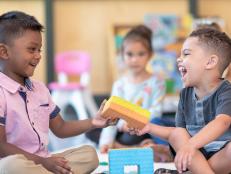The Best Way to Raise Resilient Kids, According to a New Study
Here’s how creative thinking in school can help kids with their own everyday problems.


Stephen Simpson
There have been countless books written on the "right" way to raise kids, and if you want more opinions, just ask friends and family. They’ll have their opinions too. When it comes to raising a resilient child who can deal with life’s ups and downs, one study says for young children, being creative takes them far in life.
According to a recent study published by The Ohio State University in the Journal of Creativity, elementary school students who are shown how to be creative can use those skills to increase their resilience in the face of real-life problems later in life.
"There are concerns about the resiliency of American children in the wake of COVID-19 and this sense that many kids are having a hard time in school and in life," said Angus Fletcher, lead author of the study. "Creativity training can help kids come up with a second plan when things aren't working out for them."
For the study, researchers used what is called narrative creativity training with a group of 32 third, fourth and fifth graders living in Columbus, Ohio. The kids are taught dramatic and literary techniques such as perspective shifting, counterfactual (what-if) thinking, and causal (why) thinking to help improve real-world problem solving.
The students were split into two groups. The first group was taught perspective shifting by being asked to think of a friend who had special skills and could help them solve any problem. The kids were told to think of this friend as their "creative friend." This helps kids shift their perspective and view a problem through someone else’s eyes. In contrast, the second group was only asked to identify a special quality within themselves.
Then, both groups were then presented with a problem: not being able to go to a birthday party because you’re out of town. Students were also asked to think of everyday problems in their own lives. What they found was 94% of the group who used perspective shifting came up with solutions to this problem. However, less than half of the students in the other group were able to solve the birthday party problem and none of the second group could come up with a solution for their own problems.
The teachers working with the kids noted that of the solutions, the most creative solutions came from students in the first group. So, not only were these students more likely to have a solution, but the quality and creative nature of the solution also exceeded students in the second group.
"When you ask people to shift their perspective and imagine receiving advice from a friend, you get a lot more creative and effective solutions to problems than just trying to solve the problem yourself," Fletcher said.
Researchers then conducted a second study where 28 students took a five-day narrative creativity curriculum workshop where students were taught a variety of narrative creativity techniques. At the end of the training, kids were again presented with another problem and asked to think of their own everyday problems. However, this time researchers provided an unexpected challenge when kids shared the solutions to their problems. Researchers responded by telling kids their solution wouldn't work.
What they found was every student who took the course was able to provide a second solution to both the given problem and their personal problems
"If children can't solve a problem, we train them to back up and think about what they are trying to accomplish — the why problem," Fletcher said. "Step back and say why does this matter? We often find that if you think more broadly about what you are trying to accomplish, and why it is so important, then you can see there are other ways of getting what you want."
According to Fletcher, this study proves there are ways we can help teach our kids to cope with their problems. He also adds that teaching kids narrative creativity can be done in fun ways that kids of all ages will understand and engage with.
"The ability to use this type of thinking can't be assessed via standardized tests. But it is still very important and can help children use and grow their creativity to solve real-world challenges," he said.
YOU MIGHT ALSO LIKE:















